 Denys Rudyi - Fotolia
Denys Rudyi - FotoliaDemography at a glance
The EC has launched its EU demography atlas.
KL – 05/2021
On 29 April 2021, the EC launched its
digital EU demography atlas, which is an interactive tool for
monitoring and anticipating demographic changes within the EU. The atlas was
developed by the EC’s joint research centre (JRC).
Information about its use as a reference
work is dealt with here: the EU demography atlas aims to provide quick and easy
access to a wide range of demographic data and knowledge. It provides users
with clear information from a combination of official statistics and forecasts
from Eurostat and new data from the JRC with high spatial resolution. The
contributions about demographic trends are linked to various policy areas. The
EU atlas concept also provides for adaptations and extensions to meet the needs
of the various policy areas.
User group
The EU demography atlas is publicly
available to a wide range of users. The EU atlas will provide the EC with
the option to use the information to develop and improve policies. It is
intended to support activities in various policy areas such as health, employment
and education. However, the EC does not envisage that its use will be limited
to EU institutions. Instead, it could also be used, for example, in the
teaching of school classes.
Demographic changes
The EU demographic atlas aims to provide
knowledge about the development and impact of demographic changes within the
Member States. The information can be broken down by region. The starting point
for developing the EU atlas was the increasing ageing of societies and the
decline in the working-age population in the coming years. Shifts are taking
place as a result of the mobility of young Europeans. This can have very
different effects on cities and rural regions in the EU.
Effect on political initiatives
The EC has been researching the impact of
demographic changes within the EU for some time. Last year it published its
initial report on this subject. This EU demographic atlas is
another tool for the EC to respond to the negative impact of demographic change
on the economy and social cohesion. The information will also feed into the
EC's decision-making processes regarding the EU’s “Rights of the Child”
strategy and the Green Paper on Ageing (see report 4/2021).
